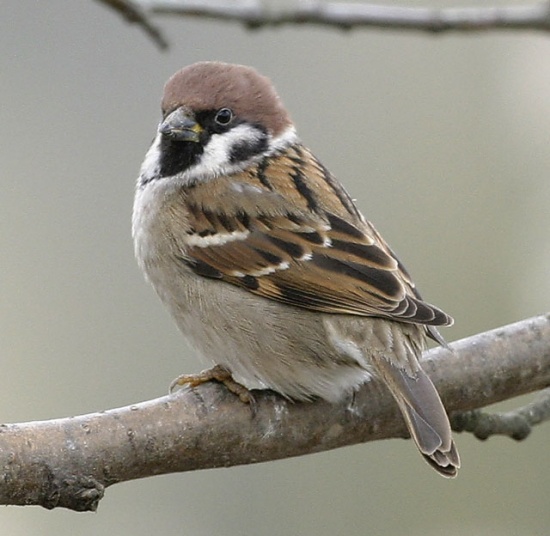- Passer montanus
Identification
Chestnut crown and nape. White cheeks with a black spot.
Similar Species
House Sparrow, which has a grey head and lacks the white cheeks.
Distribution
Widespread and still fairly common but decreasing in parts of western Europe including Britain.
Breeds in coastal Ireland and Britain (but rather uncommon in the north), and from western France, north and eastern Iberia east across Europe to the Urals and Caspian reaching coastal and southern Scandinavia, the Baltic States and the White Sea. In the south occurs on the Mediterranean coasts of Spain and France, Italy and Sicily, the Balkans, patchily in west, central and northern Turkey and the Caucasus. Formerly bred in the Faroes and has bred Morocco, recently in Malta and Gozo] introduced to Sardinia.
Rare breeder in the Canary Islands, found only on Gran Canaria. There is also a small population in St. Louis, Missouri, in the USA.
Resident or partial migrant over most of range and winter visitor to the larger Mediterranean islands.
Vagrants recorded in Gibraltar and North-West Africa, Egypt and Israel.
Introduced to Australia. Now found in a few places in the south-east. Locally abundant.
Taxonomy
Subspecies[1]
- P. m. montanus: Europe to north Africa, northern Mongolia, Manchuria and Sea of Okhotsk
- P. m. transcaucasicus: Southern Caucasus (Black Sea coast of Georgia to northern Iran)
- Generally duller and greyer above, whiter below
- P. m. dilutus: Transcaspia to western Pakistan, Gobi Desert and western China (Xinjiang)
- P. m. dybowskii: Eastern Asia (lower Amur River to Manchuria and northern Korea)
- P. m. kansuensis: Western China (Zaidam basin and northern Gansu)
- P. m. iubilaeus: Eastern China (Liaoning to lower Yangtze River and Shaanxi)
- P. m. obscuratus: Nepal to north-eastern India, Myanmar and west-central China (Sichuan to Hubei)
- P. m. saturatus: Southern Kuril Island, Japan, South Korea, Ryukyu Island, Taiwan and south-eastern China
- P. m. malaccensis: Central Myanmar, Malaya, Hainan, Vietnam and western Indonesia
Habitat
Open woodland and along woodland edges, parkland and farmland with copses and hedgerows. Also in urban areas where House Sparrow is absent.
Behaviour
Highly gregarious, this bird prefers the vicinity of humans.
Breeding
Secondary cavity nester. Not aggressive or pugnacious like the House Sparrow, but may attempt to claim a box used by another bird.
Vocalisation
<flashmp3>Passer montanus (song).mp3</flashmp3>
Listen in an external program
References
- Clements, JF. 2009. The Clements Checklist of Birds of the World. 6th ed., with updates to December 2009. Ithaca: Cornell Univ. Press. ISBN 978-0801445019.
Recommended Citation
- BirdForum Opus contributors. (2024) Eurasian Tree Sparrow. In: BirdForum, the forum for wild birds and birding. Retrieved 19 April 2024 from https://www.birdforum.net/opus/Eurasian_Tree_Sparrow
External Links




